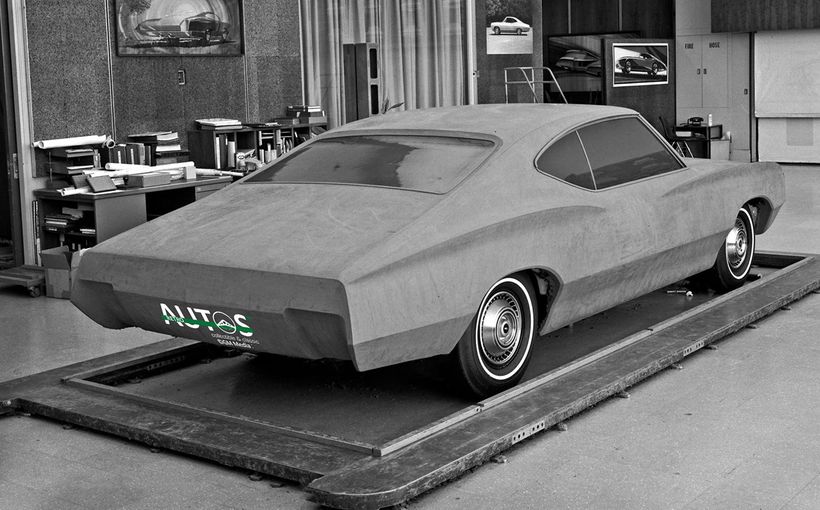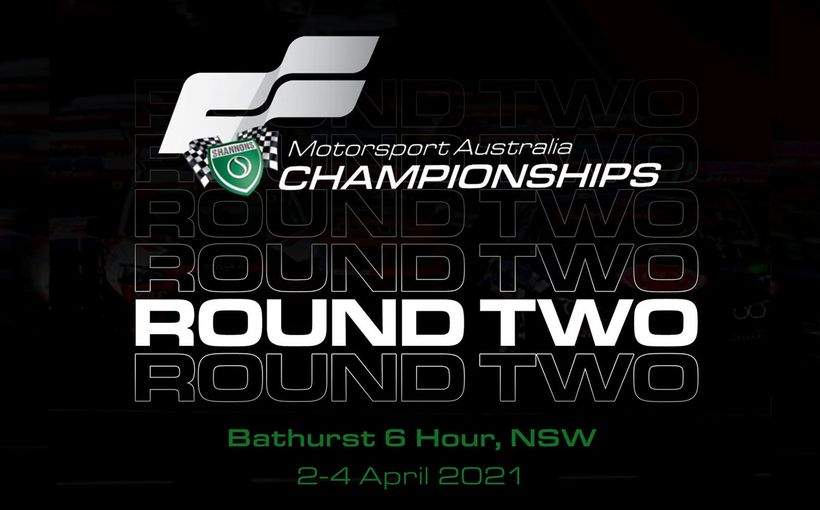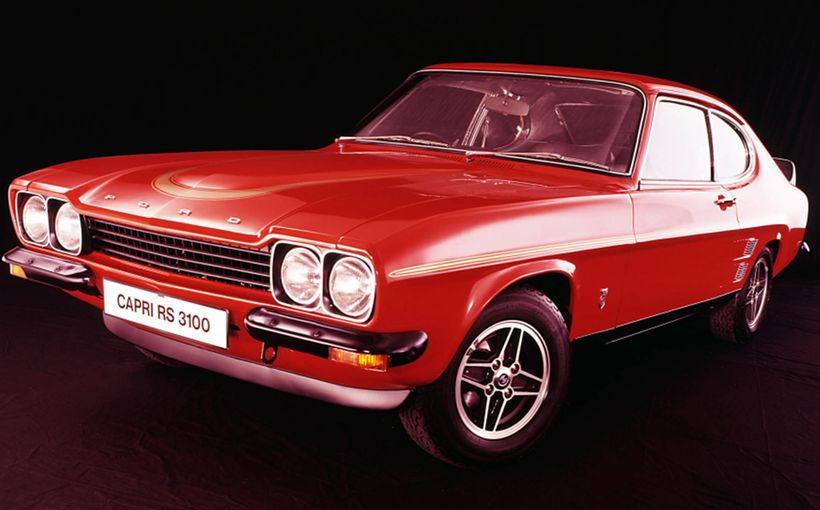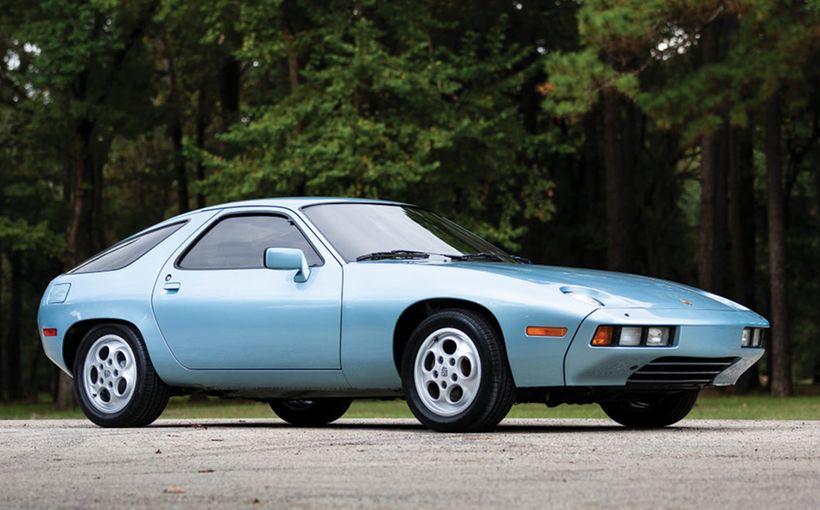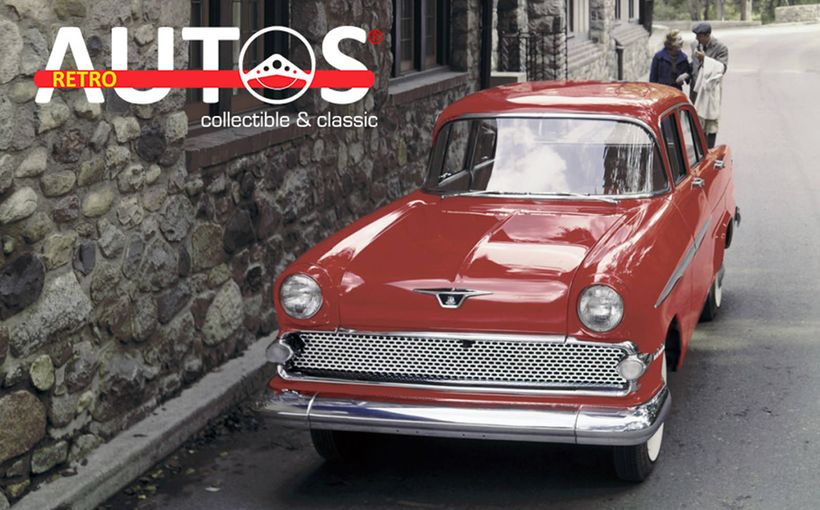Vauxhall PA Velox/Cresta: Why Holden did not win Australia’s first ‘Great Race’
By
MarkOastler -
02 March 2015

In motor racing, no one remembers who came second. Frank Coad, John Roxburgh and their mighty Vauxhall PA Cresta achieved immortality by becoming the first winners of an event that would over time become known simply as ‘The Great Race’. No one competing in the first Armstrong 500 would have had any idea how big the annual event would become. Image: www.vauxhall.org.au
General Motors holds the distinction of being outright winner of the first Armstrong 500 held at Phillip Island in 1960. However, the winning car was not a Holden. In fact, there were no Holdens entered, which is surprising given the huge popularity of ‘Australia’s Own Car’ at the time.
The victory went to the UK-designed Vauxhall Cresta, which in Australia was being assembled by GM-H from CKD kits and sold as an upmarket premium-priced model through selected GM dealers. Frank Coad and John Roxburgh created history by being the first outright winners (even though there was no award for first-across-the-line honours in those days) of a race that would within only a few years move to Bathurst and become a national – and international - sporting institution.
So why wasn’t even one example of the then-current model FB Holden on the starting grid for this pioneering event? According to a report in Sports Car World magazine, three Holdens had been entered by prominent Melbourne Holden dealers but were all withdrawn prior to the race because of incurable engine oil surge.
On face value, the Holden and the Vauxhall appeared to be evenly matched contenders for a victory in Class D (2001-3500cc) and a good shot at line honours, even though there was no prize for the outright winner in those days.

In 1960 GM-H commanded a staggering 50 percent of the Australian car market and its latest FB model (pictured) was selling up a storm, making it conspicuous in its absence from the first Armstrong 500. At the time GM had a global corporate ban on factory involvement in motor racing. However, that ban didn’t extend to Holden dealers who could do what they liked. It was a golden opportunity missed to prove how rugged and well suited ‘Australia’s Own Car’ was to local conditions. And certainly raised a few question marks.
The FB Holden and PA Cresta had similar US-inspired ‘tail fin’ styling. They rode on the same 105-inch (2700mm) wheelbase and their overall lengths, heights, kerb weights and weight distributions were fairly close.
Both cars were powered by inline six cylinder overhead valve engines of around 138 cid or 2.2 litres in capacity. They also had three-speed manual gearboxes with column shifts, coil-sprung wishbone-type independent front and leaf-sprung live rear axle suspensions, four wheel drum brakes and rugged unitary construction.
However, looks can be deceiving. If you had to pick the latest Australian offering from General Motors in which to face the unknown perils that lay ahead in the first Armstrong 500, the Vauxhall PA Cresta was a better tool for the job.
The Cresta (82.5 bhp/62kW) had noticeably more power than the Holden (75 bhp/56kW) and a slight edge in torque. The Vauxhall was also nearly two seconds quicker on the standing quarter (20.1 secs) and could hose the Holden all the way to its much higher top speed of 96 mph (154 km/h).
That extra grunt didn’t come for free, as the Vauxhall was slightly thirstier. However, the British car’s four big brake drums and linings boasted a much larger ‘swept’ area; a crucial consideration when racing a mass-produced, showroom stock production car. All up it proved to be a winning combination.

The PA Vauxhall was already building a sporting reputation in the UK and Europe before proving its speed and ruggedness in front of an Australian audience. This is the original PA model with the ‘mouth organ’ grille competing in the icy Monte Carlo Rally in 1960. Image: www.goodoldvalves.tumblr.com
1960 Armstrong 500
The Light Car Club of Australia’s original plan for Australia’s toughest touring car race was to stage a 500-mile (800 km) enduro around Melbourne’s Albert Park Lake.
This was inspired by some enthralling sprint races held there in the 1950s, starring greats like Len Lukey and Norm Beechey in their power-sliding
V8 Ford Customlines. It was felt that a distance of 500 miles (800 kms) would severely test the durability of cars sold in Australia.
However, Melbourne City Council rejected the proposal due to traffic and noise issues. If they had known then that the proposal they knocked back would grow into the national sporting colossus it became, they may have been more accommodating. Today’s F1 Australian Grand Prix shows they didn’t make the same mistake twice.
The only other circuit in Victoria considered suitable was at Phillip Island, operated by the Phillip Island Auto Racing Club (PIARC). The LCCA approached the club and with the backing of race sponsor Armstrong they hired the fast, sweeping 3.0 mile (4.8 km) circuit for the weekend of November 19-20, 1960.

The Coad/Roxburgh PA Cresta powering towards its famous 1960 victory at the Island. Note how close the circuit was (is) to the rugged Bass Straight coast. And how badly the track surface was starting to break up, with one of many potholes starting to emerge right in front of the winning Vauxhall. Local GM dealers enjoyed a big increase in showroom traffic after the Cresta’s win.
Armstrong York Engineering P/L was a local manufacturer of automotive shock absorbers and like all components suppliers was keen to secure OEM (Original Equipment Manufacturer) status with major local car makers/assemblers.
Armstrong couldn’t have picked a better event in which to demonstrate the durability of its equipment in full public view. 500 miles of torture for tyres, suspensions, engines and brakes. The longest race of its kind. The company went in boots and all, offering almost £6,000 in prize money to be shared across five classes based on engine capacities, plus a team’s prize. It was billed as the world’s richest production car race.
Phillip Island has always been a magnificent motor racing circuit. Its open, undulating, high speed layout presents a formidable challenge for drivers and a vast choice of viewing options for spectators. Back in 1960, its only potential problem as host venue for a 500-mile race was the track surface itself, which had been laid several years before using a cold-mix bitumen and gravel compound.
Cold-mix road building was common at the time, as the smooth, hard-wearing hot-mix compounds we take for granted today were not widely available in Australia in the 1950s. And as many Australian motorists of those times would attest, roads in those days could not withstand much punishment. After only three Armstrong 500s, the Phillip Island track would be reduced to rubble.

BMC Australia took its factory-backed motor sport program very seriously, as can be seen by this elaborate all-weather pit lane structure erected specially for the race. The works-entered Morris Majors and Austin Lancers had mixed fortunes, with the best result being second in Class C for the Peter Manton/Barry Topen Morris Major.
The rules for that first race were naively simple, yet provided a stable foundation from which this famous event would quickly build. For starters, all cars had to be manufactured or assembled in Australia, with a minimum of 100 units having been sold and registered to be eligible to race.
Not surprisingly, it wouldn’t take long for the 100-minimum rule (later raised to 200) to be exploited by manufacturers seeking an unfair advantage. The production of small batches of road registered ‘race specials’ would become a nightmare for event organisers and road safety campaigners by the early 1970s.
For 1960, the cars had to be stock-as-a-rock showroom specification, with the only freedoms being aftermarket bolt-on items like shock absorbers (Armstrong of course), tyres and batteries.
To improve driver safety, seat belts could be fitted (at a time when they were optional in new cars) and hubcaps removed. With the hazard of flying rocks and gravel expected, mud flaps were mandatory and windscreens could be either laminated or shielded by a sheet of Perspex. No driver could drive more than 300 miles (480 kms).
With the emphasis on durability, all cars had to complete the first 100 miles (160 km) without stopping for fuel, oil or a driver change. Any mechanical trouble that occurred during that time had to be fixed by the driver, without any help from his pit crew.

The Russell/Anderson/Loxton Peugeot 403 did an outstanding job in not only dodging all the potholes (check 'em out!) but also trouncing the BMC works team to win Class C and finish second outright to the Coad/Roxburgh Cresta. Debate raged for decades about whether the Peugeot had actually beaten the Vauxhall until CAMS finally laid the controversy to rest in the early 1990s (see story).
Intriguingly, the winner of each class would be decided when the first car in the field completed 500 miles, yet there would be no award for outright winner. It didn’t take long for that to change either!
The bumper field of 47 cars was spread across five classes comprising Class A (up to 750cc), Class B (751-1300cc), Class C (1301-2000cc), Class D (2001-3500cc) and Class E (over 3500cc). These represented brands as diverse as GM, Ford, BMC, Peugeot, Renault, Simca, VW and NSU.
Being a new event with such a rich prize pool, the Armstrong 500 attracted the cream of Australian racing talent; multiple AGP winners Doug Whiteford and Lex Davison (NSU Prinz), Norm Beechey and John French (Standard Vanguard), Bob Jane and Lou Molina (XK Falcon), Harry Firth and John Reaburn (Singer Gazelle), Bill Pitt, Des West and the Geoghegan brothers (Renault Dauphines), Eddie Perkins, George Reynolds, David McKay and Greg Cusack (VW Beetles), ‘Gelignite’ Jack Murray (Simca Aronde), Bob Holden (Peugeot 403), Brian Foley (Austin Lancer), Peter Manton and Brian Muir (Morris Majors) and Murray Carter (Ford Customline) to name a few.
The Coad/Roxburgh Cresta, the only Vauxhall in the race, was entered by the S.A Cheney dealership in Melbourne, which in itself was steeped in local GM history. Sydney Albert Cheney was one of the pioneers of selling GM-owned British vehicles in Australia, having secured an agency for Vauxhall cars and Bedford trucks in 1932.

Winners are grinners. The Coad/Roxburgh PA Cresta appears to have a mile-wide smile as it takes the chequered flag to win the first Armstrong 500. It was the greatest motor sport achievement for Vauxhall in Australia and would not be matched by its GM stablemate Holden until 1968 at Bathurst. Note the competing billboards for rival oil companies Shell and BP.
By the late 1950s he’d expanded to selling Holdens, but wisely the Cresta was considered a better option for this demanding race (Cheney would later merge with racing great Bill Patterson to form Patterson Cheney Holden).
The 1960 Armstrong 500 featured a classic Le Mans start in which the drivers had to line up on the opposite side of the track and run to their cars, strap in and go. Even so, the five classes were released at 10-second intervals in the reverse of their alphabetical order, with the larger more powerful cars getting away first.
Speedy Tasmanian brothers John and Gavin Youl in their
Mercedes 220SE away with the Class D and outright lead, building more than a lap’s buffer over the field. However, as the track started to fall apart, their mercurial Mercedes punctured a tyre and barrel-rolled out of the race after 66 laps.
That left the Coad/Roxburgh Vauxhall in a commanding lead, despite taking a more conservative approach than most. According to race reports, they stopped for new brake linings and completed three complete tyre changes.
After 167 laps and almost eight and half hours of racing, their bruised, battered and bug-splattered Cresta crossed the finish line to an enthusiastic reception from the 40,000-strong crowd. Only 35 of the original 47 starters were still circulating at the finish.

The victory by John Roxburgh (left) and Frank Coad (right) in the ‘World’s Richest Production Saloon Car Race’ was widely celebrated. Roxburgh would later oversee Japanese manufacturer Nissan’s early involvement in Australian touring car racing in the 1960s, establishing the works-backed Datsun Racing Team in Melbourne. It achieved great success in the small car classes, particularly at Bathurst.
In second place outright was the Class C-winning Peugeot 403 driven by Geoff Russell, David Anderson and Tony Loxton. This car and its official race result (167 laps completed) were to be the focus of much controversy for decades after the race, with many claims that it was in fact the outright winner. These disputes were common when official lap scoring was done manually with teams of volunteers using stop watches, paper and pen.
The issue was finally laid to rest in 1992 when Graham Hoinville, a respected race and rally driver/navigator working for the Confederation of Australian Motor Sport (CAMS) at the time, did a forensic analysis of every lap of the race including pit stops. He concluded beyond debate that the winning Vauxhall completed its final lap (167) only seconds after the Peugeot commenced its 164th lap.
In any case, it was an outstanding performance by the Class C-winning Peugeot crew in completing more laps than any other car in the race, including Murray Carter’s big V8 Ford Customline that won Class E. The Simca Arondes dominated Class B with an emphatic 1-2-3 finish; a result mirrored by the tiny NSU Prinz from Germany which claimed the top three places in Class A.

Tough times in the local car industry resulted in a depleted field for the second running of the Armstrong 500 in 1961. It was still a cracking race, though, full of drama and excitement. Note how the classes were released at 10-second intervals to reduce the chance of a first corner pile-up. The Coad/Roxburgh Velox chased the Studebaker Larks and lone Ford Customline as Class A was first away, but the outright winner would come from Class B. Note the complete lack of safety fencing, allowing spectators to stand right on the edge of the track. How did we ever survive the 1960s?
1961 Armstrong 500
The first Armstrong 500 had been a great success. The two big questions to be answered for the 1961 race were if the Vauxhall boys could win it again. And if the track could withstand another 500 miles of punishment, after it had been badly knocked around by the 1960 race.
“Out across the barren tea-tree and the spiky, wind-flattened coastal tufts, tired, sunburned officials surveyed what was left of their circuit,” reported Sports Car World after the 1960 race. “Phillip Island, eight hours before a track of which any club could be proud, was a dustbowl. Great potholes, three feet across and up to nine inches deep, scared the surface at every major turn. At one place there was nothing but dirt for 30 ft, at another a chain of holes it would take a week to fill.”
Even so, race sponsor Armstrong was positively buzzing, boosting prize money to £8,000 pounds in expectation of another bumper field. However, entry numbers fell sharply with only 26 cars on the grid.
An economic recession at the time had put a squeeze on credit which had a crippling effect on the local car industry. As a result, manufacturers and dealers weren’t flush with the spare funds needed to go racing. The 1960 race had also quickly shaken out the professionals from the amateurs.
To reflect changes in the local industry, the classes were reduced from five to four and the engine capacity limits were adjusted, with Class D (up to 1000cc), Class C (1001-1600cc), Class B (1601-2600cc) and Class A (over 2600cc).

The Coad/Roxburgh PA Velox was topping 100 mph (160 km/h) down the main straight in 1961, thanks to a bigger 2.6 litre engine and taller gearing that made the UK-designed Vauxhall a formidable opponent. The reigning champions showed race-winning pace throughout practice and early in the race until an off-track excursion blunted their performance. They still finished third.
1960 winners Coad and Roxburgh were back in another PA model Vauxhall, but this time it was the cheaper and less luxurious Velox model, which made sense given the merciless flogging it was about to endure.
Again backed by Cheney of Melbourne, it was the latest version of the PA model released in February 1961, equipped with a larger and more powerful 2.6 litre engine boasting big increases in power and torque. The extra grunt allowed a taller final drive ratio, larger diameter 14-inch wheels and a 100 mph (160 km/h) top speed. The bigger wheels provided more sure-footed high speed handling and more room for larger front brake drums.
The 2.6 litre Velox was at short odds to repeat Vauxhall’s class win and outright line honours, but it faced new competition from what would become a growing V8 presence in the Great Race; this time from a pair of
Studebaker Larks.
With their lusty 259 cid (4.2 litre) V8s and speed to burn, one Lark was entered by then NSW distributor York Motors for Brian Foley and Sydney motoring writer David McKay. A second Lark entry was lodged by Victorian Studebaker distributor, Canada Cycle and Motor Company, shared by Victoria Police Motor Sports Club (VPMSC) team members Fred Sutherland and Bill Graetz who were both serving police constables.

Pit stops for the Coad/Roxburgh Velox and McKay/Foley Studebaker Lark in 1961. Note the prominent Holden/Repco signage displayed on the Vauxhall’s pit area. And the cameramen perched on top of the pit lane buildings, covering the action with the good old reel-to-reel movie cameras of the era. Live TV coverage of motor sport was in its infancy.
Fastest car in Saturday’s practice was the Coad/Roxburgh Velox, lapping very smartly in the 2 min 45 sec zone. Interesting to compare those times with the 2 min 54s by the first Holden to appear in the 500; an EK model driven by John Lanyon/Ian Strachan. There was still nothing for Holden fans to cheer about, as it was also no threat to its Mercedes competition in Class B.
The Vauxhall’s speed concerned the Studebaker teams. If they had to run harder in the race than planned to keep up, they would wear out tyres at a faster rate on a track that was now heavily patched-up and increasingly fragile.
Race day dawned hot and windy, with a big crowd pouring into the circuit from first light to be all set when the starter’s flag fell at 7.30 am. As expected the Class A hot-shots thundered off into the distance and after 34 laps, the prescribed 100 miles (160 kms), the Vauxhall and V8 Larks were the first to pit for fuel, a driver change and maybe tyres.
The Vauxhall crew worked efficiently to get their car back on the track with minimum time lost, but it was not long after that the 1960 winners saw their chance of back-to-back wins evaporate.

Holden made its first appearance in the Armstrong 500 in 1961, with this EK driven by Ian Strachan and John Lanyon in Class B. Although GM had a global corporate ban on motor racing at the time, this car was reportedly prepared for the race after hours by staff at Holden’s vehicle proving ground at Lang Lang. That might explain the large letter ‘H’ displayed on the bonnet. Note how the front bumper, front panels and lower rear quarters have been heavily taped to minimise damage from flying rocks and gravel. The car was disqualified after 134 of 167 laps reportedly for using replacement parts during the race that were not sourced from its own pit crew's supplies.
Noted author Bill Tuckey captured this pivotal moment in Australia’s Greatest Motor Race: “Roxburgh took over the Vauxhall from Coad and proceeded to turn laps in 2.47 and 2.48. His tactic was to put extra pressure on the (much heavier) Studebakers and wear out their tyres, but after four laps he paid the penalty, having a giant ‘off’ at KLG (the fast right-hand sweeper at the end of the main straight) and bouncing across a small gully, damaging a front wheel and putting the front end so far out of alignment that the Velox promptly started wearing out tyres faster than the Studebakers!”
By late in the race, the Class A-leading McKay/Foley Lark was cruising along more than a lap ahead of the Vauxhall and the other Lark, but the actual outright race leader was the Class B Mercedes Benz 220SE shared by Bob Jane and Harry Firth.
After an early race puncture dropped them two laps behind, Jane and Firth staged a mighty comeback. Their masterful display of driving balanced high speeds with mechanical sympathy, to preserve the car and its vulnerable tyres.

The Coad/Roxburgh Velox kicks up some dust as it sweeps through the loose gravel that characterised the hazardous Phillip Island track in the early 1960s. Note how the driver is casually resting his elbow on the driver’s door; something often seen during Peter Brock’s amazing career.
This tactic, combined with fast pit stops, resulted in the Mercedes pair not only dominating Class B but also overhauling the Class A Larks and Vauxhall to be declared the (unofficial) outright winners.
As expected the two Studebakers were fast and reliable, displaying none of the chronic brake and wheel problems that would cripple them in later years at Bathurst. The American cars sandwiched the Velox in finishing first and third in Class A, second and fourth outright.
For Coad and Roxburgh it was a winning opportunity lost, given the ominous speed the latest 2.6 litre Velox displayed in practice and the early stages of the race. They steeled themselves to return and finish the job.

The Coad/Roxburgh Velox is readied for the traditional Le Mans start as it takes its place alongside Class A competitors prior to the 1962 Armstrong 500. The appalling condition of the Phillip Island track would extract a heavy mechanical toll, including the lone Vauxhall. Race program image: www.forum.autosport.com
1962 Armstrong 500
The third and final running of the Armstrong 500 at Phillip Island attracted a tremendous field of cars and drivers. The previous year’s economic recession had eased, car sales were rebounding strongly and the car makers and their dealers had regained confidence.
This was reflected in the big 41-car entry list, boasting 18 different models from the total of 28 that were eligible. The four-class structure remained, but the cars were now grouped according to their retail prices rather than engine capacities: Class D (under £900), Class C (£901-1050), Class B (£1051-1240) and Class A (£1251-2000).
Price-based class structuring would remain in place until the end of the showroom stock racing era in 1972. This was a good move for Australia’s car-buying public as it let them compare the performance of cars within different price brackets. However, from a racing point of view, it also created some ludicrous imbalances in class battles at times.
All cars now had to be fitted with laminated windscreens. This was in direct response to the alarming deterioration of the Phillip Island track, which was now so heavily patched it resembled a patchwork quilt prior to the start. And it didn’t take long to turn into a car-munching monster.

A rare shot of the Coad/Roxburgh Velox prior to its early retirement from the 1962 race. The 2.6 litre British car still had the speed required to be a potential outright race winner that year – just not the luck.
The Class A entry was again headed by Coad and Roxburgh, returning in another 2.6 litre Velox backed by Cheney and - for 1962 - Boyded, which would become one of Sydney's largest Holden dealers (Boyded of Bankstown).
Canada Cycle and Motor Company backed the Victorian Police team again by loaning them an ex-police Mobile Traffic Section four-door Lark sedan for Sutherland and Graetz to drive, powered by the larger 289 cid (4.7 litre) 225 bhp V8 from the Hawk.
A second Lark was entered by a NSW team, this time a private entry for Don Algie/Kingsley Hibbard. Class A also hosted three of the new
R & S series Valiants with their powerful slant six engines and a works-backed Ford Zephyr Mk III.
Race day dawned bright and sunny and it was clear that the level of competition had shifted up a gear compared to the more relaxed contests seen in the two previous 500s. This was now a serious motor race, with the front runners pushing very hard from the start despite the circuit literally falling apart beneath them.

The Vic Croft/Wal Gillespie R series Valiant shows the deplorable state of the Phillip Island track in 1962. This is heading into Siberia where deterioration of the circuit’s thin bitumen crust was at its worst. It would condemn the picturesque coastal track to being replaced by Mount Panorama as future host of The Great Race.
“Weeks of heavy rain beforehand had undermined much of the thin surface and even practice saw big holes and patches begin to grow where the bitumen layer literally was simply disappearing,” Bill Tuckey wrote of the 1962 Great Race debacle.
“Few parts of the circuit stayed intact. The worst corner was Siberia, over on the ocean side, where midway through the race there was a hole a metre wide and almost two metres long and contemporary accounts said six inches (150mm) deep. The result was what resembled nothing so much as an eight-hour special stage of a round-Australia trial.”
After 40 minutes the Hibbard/Algie Lark led Class A, with the Vauxhall second and the police Lark in third. But the brutal track craters were extracting a heavy toll, with the Coad/Roxburgh Velox forced to retire after only 64 laps due to a broken tie-rod and terminal steering damage.
Similar stories were being told the length of pit lane; suspensions deranged and tyres punctured by giant potholes, radiators wrecked by severe chassis flexing and flying stones, windscreens cracked by large rocks and the fronts of cars grit-blasted back to bare metal by airborne gravel. Australia’s greatest race had descended into a farce.

Pit stop for the Coad/Roxburgh Velox, which succumbed to steering damage in what was its third and final appearance in The Great Race. The PA Vauxhall could well have been a multiple winner had things gone their way. Note the lap-type seat belt hanging beneath the driver’s door. Proper four-point racing harnesses were still many years away.
Following the retirement of the lone Vauxhall, the two rugged Studebakers set the pace for the remainder of the race – or so they thought.
In the closing stages, Sutherland and Graetz were confident that even though the XL Falcon (Class B) driven by 1961 winners Bob Jane and Harry Firth had caught and passed their Lark, according to the official lap charts they were comfortably leading Class A and still almost a lap ahead of the Ford in outright terms.
The Studebaker was shown the chequered flag and Sutherland/Graetz named as the outright winners. However a protest and lap re-count demanded by the Ford team resulted in the Lark drivers being classified as finishing on the same lap as the Firth/Jane Falcon - but 21 seconds behind!
Due to the appalling state of the Phillip Island track, the 1962 Armstrong 500 was the last to be held there. 1962 was also the final time we would see Vauxhall’s PA Velox/Cresta, but its legacy as the first winner of Australia’s Great Race will endure.




















